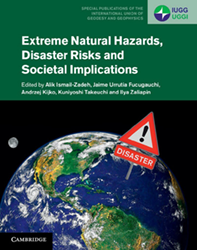Overview
Special Publications of the IUGG are a series of books which were co-published between 2014 and 2023 by the IUGG and Cambridge University Press.
Volumes in the series present major scientific developments and achievements derived from programs, assemblies and symposia run by the eight IUGG Associations, and provide researchers and graduate students with authoritative insights into state-of-the-art research across the Earth Sciences.
Many contemporary problems within the Earth sciences are complex, and require an interdisciplinary approach. This book provides a comprehensive reference on data assimilation and inverse problems, as well as their applications across a broad range of geophysical disciplines. With contributions from world leading researchers, it covers basic knowledge about geophysical inversions and data assimilation and discusses a range of important research issues and applications in atmospheric and cryospheric sciences, hydrology, geochronology, geodesy, geodynamics, geomagnetism, gravity, near-Earth electron radiation, seismology, and volcanology.
Highlighting the importance of research in data assimilation for understanding dynamical processes of the Earth and its space environment and for predictability, it summarizes relevant new advances in data assimilation and inverse problems related to different geophysical fields. Covering both theory and practical applications, it is an ideal reference for researchers and graduate students within the geosciences who are interested in inverse problems, data assimilation, predictability, and numerical methods.
The first volume of the series „Extreme Natural Hazards, Disaster Risks and Societal Implications” is based on the results of the ENHANS Project led by IUGG and supported by several international, national, and intergovernmental organizations.
The book presents a unique, interdisciplinary approach to disaster risk research, combining cutting-edge natural science and social science methodologies. Bringing together leading scientists, policy makers and practitioners from around the world, it presents the risks of global hazards such as volcanoes, seismic events, landslides, hurricanes, precipitation floods and space weather, and provides real-world hazard case studies from Latin America, the Caribbean, Africa, the Middle East, Asia and the Pacific region.
Avoiding complex mathematics, the authors provide insight into topics such as the vulnerability of society, disaster risk reduction policy, relations between disaster policy and climate change, adaptation to hazards, and (re)insurance approaches to extreme events. This is a key resource for academic researchers and graduate students in a wide range of disciplines linked to hazard and risk studies, including geophysics, volcanology, hydrology, atmospheric science, geomorphology, oceanography and remote sensing, and for professionals and policy makers working in disaster prevention and mitigation.
The second volume of the series „Dynamics and Predictability of Large-Scale, High-Impact Weather and Climate Events“ is based largely on an International Commission on Dynamical Meteorology (ICDM) workshop.
It covers a range of important research issues related to high-impact weather and extreme climate events. Dynamical linkages between these extremes and various atmospheric and ocean phenomena are examined, including Atlantic Multidecadal, North Atlantic, and Madden–Julian Oscillations; Annular Modes; tropical cyclones; and Asian monsoons. This book also examines the predictability of high-impact weather and extreme climate events on multiple time scales. Highlighting recent research and new advances in the field, this book enhances understanding of dynamical and physical processes associated with these events to help managers and policy makers make informed decisions to manage risk and prevent or mitigate disasters.
It also provides guidance on future research directions in atmospheric science, meteorology, climate science, and weather forecasting, for experts and young scientists.
The third volume „Global Change and Future Earth“ is derived from the work of several programs of the IUGG.
It demonstrates how multi- and inter-disciplinary research outputs from the geoscience community can be applied to tackle the physical and societal impacts of climate change and contribute to the Future Earth programme of the International Council for Science. The volume brings together an international team of eminent researchers to provide authoritative reviews on the wide-ranging ramifications of climate change spanning eight key themes: planetary issues; geodetic issues; the Earth’s fluid environment; regions of the Earth; urban environments; food security; and risk, safety and security; and climate change and global change.
Covering the challenges faced by urban and rural areas, and in both developed and developing counties, this volume provides an important resource for a global audience of graduate students and researchers from a broad range of disciplines, as well as policy advisors and practitioners.
On the centenary of the International Union of Geodesy and Geophysics, the fourth volume „Geomagnetism, Aeronomy and Space Weather“ reviews the state-of-the-art research in geomagnetism, aeronomy and space weather.
Written by eminent researchers from these fields, it summarises the advances in research over the past 100 years, and looks ahead to current and emerging studies on Earth’s magnetic field. It provides a comprehensive overview of the generation of Earth’s magnetic field, its history and its response to external forces. Starting at the centre of the Earth, the reader is taken on a journey from the interior core and mantle, through the upper atmosphere and magnetosphere, before reaching the Sun’s atmosphere and corona. The applications of this research are also discussed, particularly the societal impact of solar activity on critical infrastructures in our increasingly technologically dependant society.
This book provides a valuable resource and reference to academic researchers and students in geomagnetism and aeronomy.





